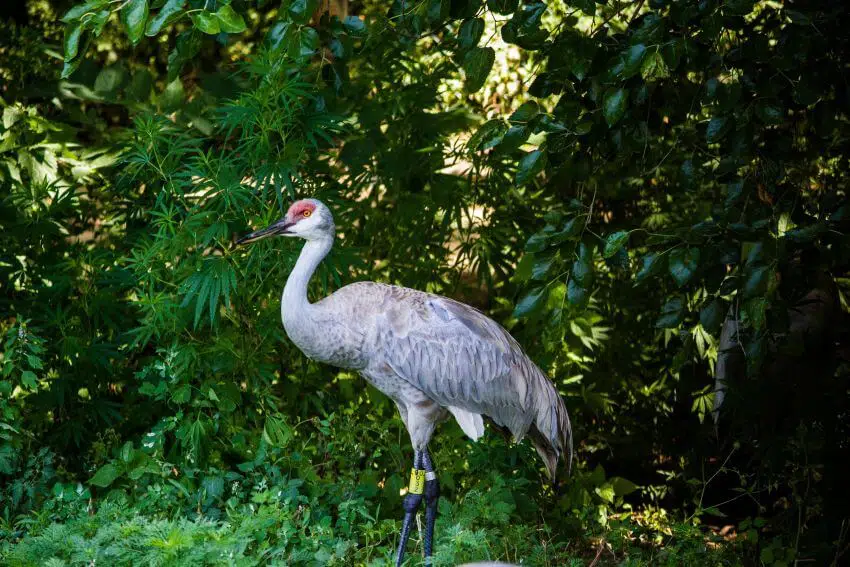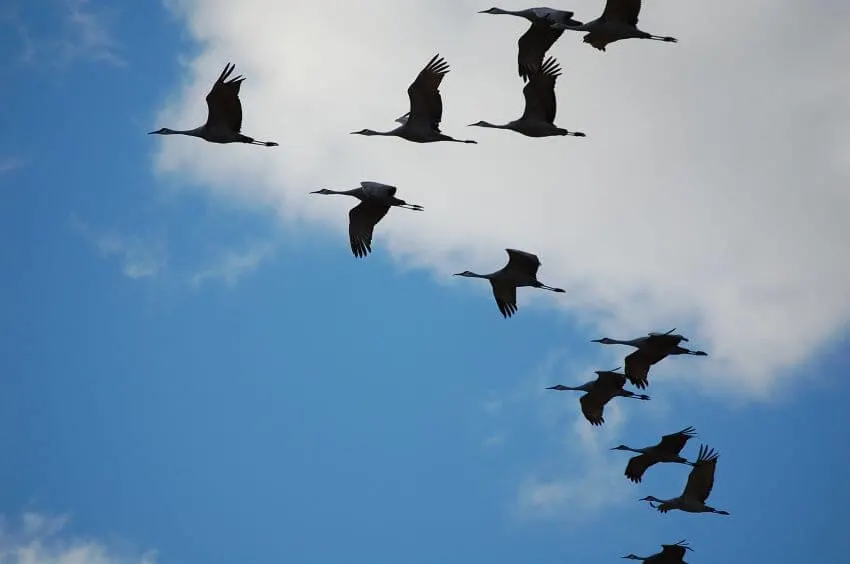Whooping Crane, who are they? What is their current status, and why are they endangered? Whooping Cranes are among the tallest flying birds in North America. Their close relatives are Sandhill Cranes which you may have seen at a local farm or zoo.
Whooping Cranes were abundant across most of Canada and the United States before European settlement began in North America, but now less than 1% of its former wild population remains.
The Whooping Crane has been listed as an endangered species since 1967 under the Endangered Species Act because it has lost so much habitat to development and pollution.

You can find Whooping Cranes on display at zoos for example at Zoo Atlanta!
The Whooping Crane is not just another bird. Whooping Cranes are unusually long-lived, with a lifespan of up to fifty years. Whooping Cranes live in large flocks until they reach adulthood and develop their pair bond for life after which they usually settle down as monogamous breeders that mate for life.
Description
Whooping Cranes are large birds that are mostly found in North America and among the rarest North American birds. Whooping Cranes have been on the endangered species list since 1967 and it is estimated that there are only around 300 Whooping Cranes left in the wild.
Thsi bird species rely on a wetland habitat to survive and they need a lot of food to maintain their size. Humans have been impacting the numbers of Whooping Cranes for some time. Hunting and habitat destruction are examples of human activity that has had a detrimental impact on these birds.
Whooping Cranes are endangered because they rely on wetlands for survival and humans have been destroying these habitats by draining them or filling them in with buildings or roads.
See Related: How Do Animals Adapt to Their Environment?
Anatomy and Appearance
The Whooping Crane’s feathers are mostly black and white with some white and orange patches. Whooping Cranes stand between 4 and 5 feet tall (1.2 to 1.5 meters) and generally weigh between 8 and 10 pounds (3.6 to 4 kilograms).
Whooping Cranes have long legs that enable Whooping Cranes to wade through water in pursuit of aquatic prey.
Whooping Crane’s eyes are black and Whooping Cranes have long, thin beaks that Whooping Cranes use to catch their prey.
See Related: Fascinating Facts About Conservation
Location
The traditional nesting grounds of the whooping crane are greatly reduced due to habitat destruction.
Migrating cranes have been using a marsh in northern Canada for breeding, flying to the southern part of the United States for the winter.
A new breeding ground has been established now in Wisconsin with birds that had been raised in captivity. These cranes are then guided down to winter quarters by using an ultra-light aircraft, which the birds follow down to Florida.
Parks where whooping cranes overwinter generally restrict access to these rare, but recovering, birds.
See Related: Reasons Why Animals Should Not Be Kept in the Zoos
Whooping Crane Habitat
The survival of the species is dependent on a wetland environment. This implies that they need access to marshes, swamps, and other locations with a lot of water. They also require a significant quantity of food to maintain their size. Whooping Crane populations have been declining due to human activity, such as hunting and habitat destruction.
Thsi bird species are not migratory birds, but they tend to spend their winters in more temperate climates where there is fresh water available for them to drink.
They generally migrate to the southern parts of the United States and Mexico during the winter months. Whooping Cranes prefer to spend their summers in protected wetland areas where there is plenty of fresh water and food for them to eat.
See Related: Most Comfrotable Animals in the World
Whooping Crane Diet and Nutrition
The Whooping Crane’s diet consists mainly of insects and aquatic life, such as snails and mussels. They need a lot of food in order to maintain their size. Whooping Cranes also eat small birds, snakes, amphibians, reptiles, and similar creatures. These species use their long legs to kick at the water’s edge in order to scare up food items.
The Whooping Crane diet is important because it helps determine why Whooping cranes are endangered. If Whooping Cranes do not have enough prey, they will not have the energy to fly or mate.
Whooping Crane food is also important because Whooping Cranes depend on wetlands which are more easily accessed if Whooping Cranes can wade in the water.
See Related: Philippine Eagle
Whooping Crane Mating Habits

Most Whooping Crane pairs tend to be on their own and not mated for life. Whooping Cranes, like many other avian species, often look for mates with which to reproduce and do not necessarily stay with the same mate over the course of their lives.
Whooping Cranes are monogamous for just one season, at least in most cases.
Whooping Cranes usually find new mates every year. Whooping Cranes nest on the dry ground not too far from water bodies such as marshes or swamps and they lay two eggs so that if one egg does not hatch, there is still a chance of perpetuating the species.
Their mate is primarily for the purpose of reproduction and they do not partake in the activities that some birds, such as robins or hummingbirds, engage in to form pair bonds.
These birds are promiscuous, which means that they may have several different mates throughout their lives.
Whooping Cranes are extremely territorial birds during the mating season and will occasionally even fight with other Whooping Cranes to establish dominance.
See Related: Animals With Best Sense of Smell
Nesting
The nest is a large mound of grass, weeds, mud surrounded by depressions at the center. Whooping crane eggs are very large and an adult Whooping Cranes needs around 1500 grams of food per day.
Whooping Cranes are also migratory birds, so they need to spend the winter in warmer climates such as in Aransas National Wildlife Refuge.
Whooping Cranes feed on fish, frogs, crayfish, and other animals. They also eat water plants like cattails roots and bulrushes. Whooping Cranes typically nest in marshes, prairies, or wet meadows near water where there is little threat of predators.
See Related: Animals That Start With X
Whooping Crane Facts
Here are some fun facts about Whooping Crane to know
- Whooping Cranes are almost entirely found in North America.
- Whooping Cranes like to eat wetland plants and insects.
- Whooping Cranes were placed on the endangered species list in 1967.
- There are only about 300 Whooping Cranes left in the wild.
- Whooping Cranes are very large birds.
- Whooping Cranes live in wetland areas because this is where they can find food to eat and other Whooping Cranes to mate with.
- Whooping Cranes are the tallest bird in North America.
- Whooping Cranes can weigh up to 30 pounds.
- Whooping Cranes have a wingspan of over 7 feet.
- Whooping Cranes live for around 20 years in the wild.
See Related: Endangered Species in California
Conservation Status

The Whooping Crane is now critically endangered, with the status having been designated since 1967. Loss of habitat, hunting, and collisions with power lines are the most significant dangers to their population.
Only around 300 of these birds remain in the wild, requiring a wetland environment to subsist.
See Related: Endangered Species in California
Threats
The whooping crane came about as close to total extinction in the 1930s as it is possible for a species to experience – only about 15 cranes remained alive. The cranes had not only been mercilessly poached, but their eggs were collected, and nesting and wintering grounds were destroyed through development.
Some predators will attack and eat either chicks or adult cranes, including bald and golden eagles, lynx, foxes, wolves, bobcats (a serious threat in Florida), and black bears.
See Related: Endangered Species in Florida
Conservation efforts
To save this beautiful bird from extinction, the efforts of the Canadian and American Wildlife Services were put into play.
All hunting and egg collecting is illegal, and refuges to protect breeding, resident, and migratory populations have been established.
Outstanding results have also been produced from captive breeding programs – eggs are incubated, hatched, then raised using whooping crane disguises so that the young birds will identify with their species.
The use of aircraft to guide the young cranes to wintering grounds and introduce them to established crane populations before migration has begun teaching the young whooping cranes how to get from breeding grounds such as the Wood Buffalo National Park in Canada to wintering areas and back again without a problem.
Cranes are heavily monitored for their protection. As some of the Gulf wintering areas are adjacent to wind farms, these facilities are shut down immediately when cranes appear in their vicinity.
See Related: Best Conservation Posters
Organizations
International Crane Foundation
The International Crane Foundation works to protect cranes worldwide and their habitats, including the Whopping Crane.
Final Thoughts
Whooping Cranes are beautiful birds that have been on the endangered species list since 1967. It is a fascinating bird species that rely on a wetland habitat to survive and they need a lot of food to maintain their size. They usually find new mates every year, but some Whooping Crane populations will only mate with one partner for life.
These promiscuous creatures can become territorial during mating season and may even fight other Whooping Cranes in order to establish dominance over certain areas or females.
Whooping cranes eat wetland plants and insects, which is why it’s so important for them to live near marshes, swamps, or wetlands where these resources grow naturally. If you’re interested in helping out whoopers (or any other animal) by donating or volunteering, check out Whooping Crane Conservation organizations.
See Related: Crowned Eagle
FAQ
What is Whooping Crane habitat?
Whooping Cranes prefer wetland habitats where they can find plenty of food. Whooping Cranes are able to live in many different types of environments but seem to thrive best when living near ponds or wetlands.
Cranes live in a wide variety of habitats from saltwater, tidal marshes to freshwater wetlands. Whooping Cranes can also survive in agricultural fields and pastures as long as there is plenty of water nearby for them to drink and enough food to eat.
Whooping Cranes tend to avoid land surrounded by deciduous forests but they prefer open areas that are surrounded by coniferous forests.
What is the Whooping Crane diet?
Whooping Cranes are mainly creatures of the wetlands and fly into dryer uplands along major river valleys including the Platte, Brazos, Red, and Mississippi Rivers.
The migrating Whooping Crane change diet as they move to other locations. When Whoopers live in high elevation wetlands such as those found at the Great Salt Lake (Utah-Nevada) or Mono Lake (California), their diets consist mostly of crustaceans like blue crabs, vegetation, and fish.
But when winter in lowland estuaries such as San Antonio Bay (Texas), Louisiana’s Barataria Basin, or Western Florida Everglades, a large portion of their food is sea bass from commercial saltwater fisheries which they catch by diving from great heights.
How old can a Whooper live in the wild?
Whooping Crane is estimated to have a lifespan in the wild of around 30 years. Whooping Cranes in captivity have lived up to 54 years old. Whoopers can live in the wild for this long, with the added benefit of not having to worry about predators or hunters.
Whoopers are unlikely to be shot at when they are on captive breeding grounds. Whoopers that are likely to be hunted tend to be Whoopers that fly over hunting territories while they are migrating.
Whooping Cranes that live in captivity, on the other hand, do not have to worry about predators either for this added benefit of not having to defend themselves. Whoopers do not need to defend themselves from threats in captivity, which is helpful since they are an endangered species.
Why is Whooping Crane endangered and what causes their extinction risk to be so high?
Whooping Cranes are endangered because of habitat loss, degradation, and fragmentation. Whooping cranes require very specific wetland habitats to survive, but these wetlands are shrinking due to climate change and development.
These bird species need a lot of food to maintain their size which has made the birds even more vulnerable. Whooping cranes are also vulnerable to powerlines that get stretched across wetlands – these can be either live or abandoned powerlines that run through important breeding grounds for Whooping Cranes.
Related Resources
